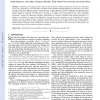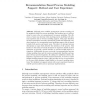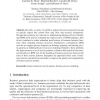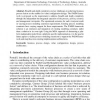TSE
2010
14 years 4 months ago
2010
— Describing and managing activities, resources and constraints of software development processes is a challenging goal for many organizations. A first generation of Software Pro...
BIS
2010
14 years 7 months ago
2010
Abstract. Process models provide visual support for analyzing and improving complex organizational processes. In this paper, we discuss differences of process modeling languages us...
WSC
1997
14 years 7 months ago
1997
This paper gives an overview of business process modeling with SIMPROCESS, its applications, unique features, basic and advanced modeling constructs, and benefits. 1 WHAT IS SIMPR...
ER
2008
Springer
14 years 8 months ago
2008
Springer
Abstract Although most workflow management systems nowadays offer graphical editors for process modeling, the learning curve is still too steep for users who are unexperienced in p...
ECMDAFA
2008
Springer
14 years 8 months ago
2008
Springer
Human participation in business processes needs to be addressed in process modeling. BPEL4People with WS-HumanTask covers this concern in the context of BPEL. Bound to specific wor...
DEXA
2008
Springer
14 years 8 months ago
2008
Springer
Recently, a variety of workflow patterns has been proposed focusing on specific aspects like control flow, data flow, and resource assignments. Though these patterns are relevant f...
BPM
2008
Springer
14 years 8 months ago
2008
Springer
The need to involve business users in process modeling is largely perceived in the context of Business Process Management systems. This can facilitate the elaboration of consistent...
SAC
1998
ACM
14 years 9 months ago
1998
ACM
Fuzzy Logic has traditionally found an application in control theory, systems analysis, and artificial intelligence [9] [7]. However, it is very difficult to apply it to tradition...
AICCSA
2001
IEEE
14 years 9 months ago
2001
IEEE
Software process modeling has undergone extensive changes in the last three decades, impacting process' structure, degree of control, degree of visualization, degree of autom...
BPM
2007
Springer
14 years 10 months ago
2007
Springer
Breadth and depth complexity are key challenges in achieving business process fusion as the enabler for value configuration design. The PARM framework is proposed as the requiremen...




